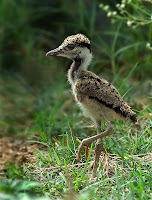It breeds from West Asia (Iraq, SW Iran, the Arabian/Persian Gulf) eastwards across South Asia (Baluchistan, Afghanistan, Pakistan, the entire Indian subcontinent up to Kanyakumari and up to 1800m in Kashmir/Nepal), with another sub-species further east in Southeast Asia. May migrate altitudinally in spring and autumn (e.g. in N. Baluchistan or NW Pakistan), and spreads out widely in the monsoons on creation of requisite habitats, but by and large the populations are resident.
This species is declining in its western range, but is abundant in much of South Asia, being seen at almost any wetland habitat in its range.
To listen the Call of Aaalkaati Patchi click this button
Call of Red-wattled Lapwing

The eggs are often collected by people and used in traditional remedies for asthma and typhoid. In parts of India, a local belief is that the bird sleeps on its back with the legs upwards and an associated Hindi metaphor Tithiri se asman thama jaega ("can the pee-wit support the heavens?") is used when referring to persons undertaking tasks beyond their ability or strength.
In parts of Rajasthan it is believed that the laying of eggs by the lapwing on high ground was an indication of good rains to come.
Use of Aalkaati patchi in Siddha Medicine
The flesh of this bird is useful in the treatment of vatha associated with venereal and skin diseases.
Egg for smallpox:
 The yolk of the bird's egg is poured in a vessel and par boiled supe¬rior variety of rice is sprinkled over it till the yolk is covered. The egg is fried with gentle heat. It is then taken out and kept stored in a clean con¬tainer. During fever caused by smallpox, this preparation is taken and placed in left hand; if a hand fistfull of this is taken out through the right hand and eaten, it will reduce tie severity of smallpox.
The yolk of the bird's egg is poured in a vessel and par boiled supe¬rior variety of rice is sprinkled over it till the yolk is covered. The egg is fried with gentle heat. It is then taken out and kept stored in a clean con¬tainer. During fever caused by smallpox, this preparation is taken and placed in left hand; if a hand fistfull of this is taken out through the right hand and eaten, it will reduce tie severity of smallpox.Note:
This bird is a protected species under the Wildlife Protection Act 1972 of India. This bird is not at all legally used in medicine in India. All the above are for information purpose only.
Download Wildlife Protection Act 1972.
![]()










2 comments:
thanks for providing information
You are welcome yuvashree!
Post a Comment